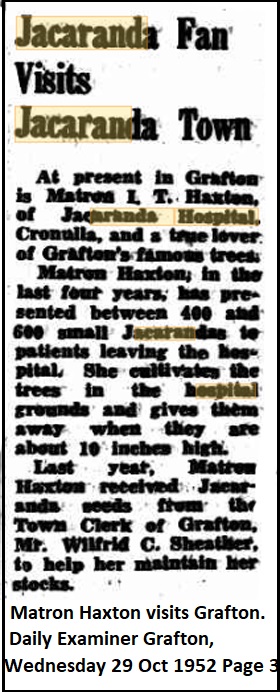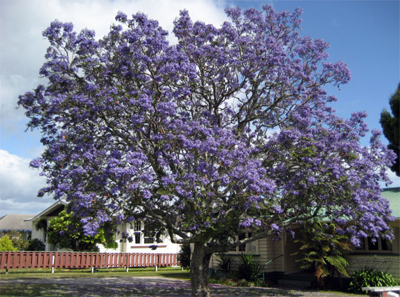
Irene Thomasina HAXTON 1905 –2002
Midwife
and Jacaranda legend
Each year in the October/November peak flowering season
for jacarandas, Sydney newspapers feature articles about these South American
natives which are prominent in certain suburban localities. Residents in a
North Sydney electorate complain about tourists who arrive in great numbers to
photograph the streetscapes and block traffic and parking. The falling flowers
are slippery underfoot on footpaths and sometimes cause accidents. Of
course, In Grafton, New South Wales, the Jacaranda Festival is a great tourist
destination and celebrated with gusto. The journalist sometimes ponders upon why
the jacaranda is so linked to certain areas and Sister Haxton’s name is always
prominent in the replies. This is her story.
Irene Thomasina Haxton nee Hooker was born on 3
July 1905 in Queensland, the daughter of George Hooker and his wife Margaret Ann
nee Booth. On 1 November 1928, Irene was living in Innisfail, Queensland,when
her registration as a General Nurse was approved and published in the NSW and
Australian Medical Registers, 1925-1954.
Ambitious to further her career, Irene, or
Reenie as she was sometimes known, had moved to Sydney, NSW, to train at
St.Margaret’s Maternity Hospital in Darlinghurst. On 29 October 1930, her name
was recorded in the Midwifery lists of the NSW, Australia Medical Registers,
1925-1954. Until 28 October 1953, with a lapse between 1941-1948, her
registration was renewed regularly.
In 1930 the
Electoral rolls show that Irene Hooker is a nurse at Dalcross Private Hospital,
Killara and in 1935 is resident at the Nurses Club in Chatswood. In 1937, she is
registered at Glebe.
In 1938, Irene
Thomasina Hooker married Vivian William Stuart Haxton at Glebe, NSW. She
was 33 and Vivian was 35. Vivian Stewart William Haxton was born at
Hawthorn,Victoria, in 1903. He was the son of David Malcolm Haxton and his wife
Isabella Florence nee Dunham. Vivian became a well known lightweight
jockey and rode with some success in Victoria and other states before travelling
overseas, returning to Australia in August 1928 on the vessel ‘Naldera’ having
boarded in Colombo. Deciding to confine his attention to New South Wales, he
relocated to Sydney with his parents and in 1930 was living in Randwick.
He picked up rides and travelled to many regional meetings but had much
competition in the metropolitan area. In December 1932 at Bega the horse he was
riding, in a trial gallop, fell on top of him. He suffered a broken
collarbone and injuries to his chest. In the 1936 electoral roll Vivian Haxton
is living with his parents at Victoria Street, Darlinghurst with no occupation.
The fall may have left him with ongoing health problems and unable to continue
as a jockey.
After their
marriage in 1938 Irene and Vivian had four children – David Anthony born on 22
March 1939 at Glebe and Paul born in 1943. In the 1943 electoral roll, they are
living in Tamworth where Vivian’s occupation is listed as shop assistant
and Irene’s as home duties. By 1945, they are back in Sydney and their
twins were stillborn.
By June 1948, Irene
Haxton had renewed her registration with the NSW and Australian Medical
Registers and approval was granted by the NSW Health Department to operate a
four bed maternity hospital with a labour ward at 12 English Street Cronulla.
With limited capital, when an opportunity arose to purchase necessary equipment,
furnishings and beds from a small hospital at Bankstown, Sister Haxton was able
to negotiate a deal to ‘pay when you can’. The hospital soon welcomed its first
patient and demand increased rapidly.
At that time, the
population of the Shire was about to explode with the postwar boom. There was a
desperate need for such a facility. The Cronulla Cottage Hospital in Croydon
Street had closed and the nearest public hospital was St George at Kogarah.There
was only the Tom Ugly’s Bridge across the Georges River and home births still
occurred.
To supplement her
income, Sister Haxton began to offer home nursing despite not owning a car and
working day and night. It soon became apparent that it was necessary to
undertake extensions to the Jacaranda Hospital as it was named. In 1952, an
adjacent block of land became available so was quickly purchased. In recognition
of Sister Haxton’s growing reputation and dedication to her work in the Shire,
the Real Estate Agent waived commission on the sale.
A loan was
negotiated and soon a new building with another four beds and a second labour
ward was opened. In those early days, Doctors Tom and Eric Miles attended the
confinements and approximately thirty two babies were born each month. In 1956
Sister Mullins and her mother joined the staff.
The Sutherland
Shire Hospital at Caringbah opened in 1958 but the popularity of the Jacaranda
Hospital continued to grow. More beds were added in 1960 and 1962. Sister Haxton
retired in 1962 and until her death in 2002 lived in Arthur Avenue, Cronulla.
Sister Mullins became Matron and soon afterwards the Maternity Hospital was
converted to a Nursing Home. More beds were added and a thirty four bed
capacity was reached in 1970. In 1979 after a period of negotiation,
Jacaranda Nursing Home, including the Matron’s Cottage, became part of Thomas
Holt Memorial Village. The title deeds to the property revealed that the land at
12/16 English Street, Cronulla, is part of the original Thomas Holt estate.
While Sydney’s
first jacaranda was planted in the Royal Botanic Garden in the late 1850s or
early 1960s, it is not known when Sister Haxton’s love affair with the South
American native began. It is known that when the hospital first became
established, she wrote to the Mayor of Grafton, where a jacaranda festival is
held each year in October, asking for some seeds to grow a few seedlings. She
would also pack her son Paul and his friend Warren Callender, who lived next
door, into the family car, drive for miles to places like Penrith where the
jacarandas grew. The boys would climb the trees, collect the pods and
later plant the seeds in jars and jam tins. A tradition was soon established. As
Mr. Callender later recalled: ‘Sister Haxton would carry the baby to the
car followed by a nurse who carried the mum’s bag in one hand and a jacaranda
tree in the other’. Matron Mullins continued that tradition.

When Michael Tynan was
Shire President in 1988-89 there was a move to remove the jacaranda trees and
replace them with Chinese tallow trees during an upgrade of the roads.
Irate locals stormed the council meeting
and Sister Haxton got up and reminded everyone that she was matron at Jacaranda
Hospital and
‘ for every baby born in my hospital I gave the parents a jacaranda
seedling.
I can stand on the top of Miranda Fair and see them in bloom and name every
child born with each tree. Everyone represents a baby to me. And, Mr.Tynan, I
brought you into this world and I gave your mother a seedling and every time I
drive past that tree I am very proud of your achievements….to date’.
Mr.Tynan was convinced by the
midwife who delivered him and so the jacarandas remained.
It is likely that 90 per cent of the shire jacarandas came from Sister
Haxton.
Irene Thomasina Haxton died, aged 97, on 15 October,
2002 and was buried at Woronora Cemetery.
Paul Haxton died, aged 18, on 31 March 1961
(Reg.No.11549) at Lithgow (road accident). He was buried at Woronora Cemetery.
Vivian Stewart William Haxton died, aged 60, at Newtown
in 1963 (Reg.No.24301).
David Anthony Haxton died, aged 45, on 28 March,1984,
at Clifton Beach, Queensland.
He was buried at Woronora Cemetery.
Click on the name at the heading on this story and you
will be taken to the entry for Irene Thomasina Haxton nee Hooker in the Data
Base on this website.
Colleen Passfield 2018
References:
NSW
BDM
Victorian BDM
Ancestry (Julie Campbell)
The Ryerson Index
Woronora Cemetery
NSW and Australian Medical Registers
Trove
Jacaranda Nursing Home
Helen Pitt,
SMH, 18/11/2018
Maria Galinovic,
The Leader, 22/11/2014


